BHANGA SINGH (d. 1815), a prominent sardar of the Karorsinghia chief ship, seized in January 1764, after the fall of Sirhind, the parganah of Pehova along the bed of the River Sarasvati, 22 km west of Thanesar. Later he captured Thanesar leaving Pehova in the possession of his brother, Bhag Singh. Bhanga Singh and Bhag Singh commanded a force of 750 horse and 250 foot. In 1779, Bhanga Singh aligned himself with the Mughal chief, Abdul Ahd Khan, to recover his territory from Raja Amar Singh of Patiala. In January 1786, Bhanga Singh along with other Sikh chiefs entered the Ganga Doab at the head of 5,000 horse and ravaged Meerut, Hapur and Garh Mukteshvar. In April 1789, Mahadji Scindia, regent of the Mughal empire, confirmed Bhanga Singh`s right to rakhi or cess levied for protection in some of the areas under his influence.
DELHI SIKH GURDWARAS MANAGEMENT COMMITTEE was a byproduct of the Akali campaign for the reformation of the management of gurdwaras in the Punjab. To wrest control of the holy shrines from the hands of a corrupt and effete priestly order, the Sikhs had set up on 15 November 1920 a body called the Shiromani Gurdwara Parbandhak Committee (SGPC), Amritsar. In 1923, the SGPC took charge of all the historical gurdwaras in Delhi as well, and formed a committee of 11 members known as the Delhi Gurdwara Parbandhak Committee (DGPC) to manage them. The SGPC, however, continued to exercise powers of control and supervision over the affairs of DGPC.
Explore the legacy of Bhai Gurbakhsh, a devoted Sikh leader who served Guru Har Krishan and Guru Tegh Bahadur, and his impact on the Jaunpur sangat.
Explore the riveting life of Shaikh Imam Ud-Din, governor of Kashmir under Sikh rule, known for his pivotal role in 1840s political strategies and conflicts.
Discover the legacy of Kharak Singh, first Shiromani Gurdwara Parbandhak Committee president and trailblazer in Sikh politics and activism.
Discover the compelling history of Mahitab Kaur, her marriage, and legacy alongside Maharaja Ranjit Singh. Explore this poignant chapter of Punjab history.
NIZAM UDDIN (d. 1802), the Pathan chief of Kasur and a tributary of the Bharigi sarddrs, overthrew his allegiance to the Sikhs and submitted to Shah Zaman, the king of Afghanistan, when the latter invaded India in January 1797. Nizam udDin took possession of the forts evacuated by the Sikhs. During Shah Zaman`s next invasion in November 1798, he presented a nazar to him and entreated that he be appointed governor of the Punjab for a tribute of 5, 00, 000 rupees annually which proposition was not acceptable to the Shah. On the retirement of Shah Zaman in 1799, Nizam udDin tried in vain to persuade the Muslim citizens of Lahore to accept him as their ruler, but they rejected the proposal and invited Ranjit Singh instead to take possession of the city.
Discover the history of Ran Singh Nakai, who expanded the Nakai misl's power and territory, shaping the Sikh region's political landscape in the late 18th century.
Explore the 1904 classic 'SIKHS, THE' by General Sir John J.H. Gordon. Delve into Sikh history, from the Ten Gurus to their role in the British Empire.
Explore Karanjit Singh's evocative poetry and translations, bringing Soviet influences to Punjabi literature with profound thought and musical grace.





